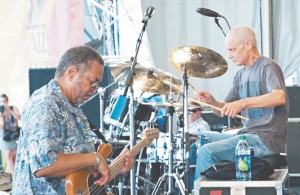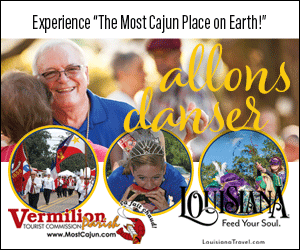Voodoo Fest displays its New Orleans culture
22nd October 2012 · 0 Comments
By Geraldine Wyckoff
Contributing Writer
It might seem unlikely that New Orleans creative jazz master, saxophonist Kidd Jordan performs at a festival that boasts acts like heavy metal vets Metallica. However, the perception of the Voodoo Music Experience (October 26 – 28) and the reality of the event are really two very different things.
That’s easily understood because during Voodoo’s early years, rap, rock and pop filled the music menu with only a scattering of New Orleans artists and other genres of music. A change came in 2006, the year after Katrina, when Preservation Hall and community radio station WWOZ each presented venues of their own that offered a broader mix of styles. Their stages, along with the Le Carnival, are side-by-side creating a musical village of sorts away from the giant speakers of the super-sized stages that showcase the headliners.
Friday’s line-ups at the Preservation Hall and OZ venues are good examples of the diversity that is presently offered at Voodoo Fest. An eye-catcher at 8:30 p.m. on the Hall’s schedule is the combination of saxophonist Jordan (not just playing Voodoo Fest but at the Preservation Hall stage), drummer Johnny Vidacovich, bassist George Porter, vibraphonist/percussionist Mike Dillon and saxophonist Skerik. Vidacovich is the only one of the group who has performed with each of the other musicians and believes he hasn’t played with Jordan since the 1970s.
“We were the new avant-gardists,” Vidacovich says with a laugh adding that he and Jordan, along with bassist Ramsey McLean and saxophonist Earl Turbinton would play together at spots like Lou & Charlie’s, the Contemporary Arts Center and the Unitarian Church.
“I don’t think it’s as radical as it seems,” he says of creative jazz’s presence at the festival. “I think this band will be just perfect because the level of energy is what the people are going to pick up on. There’s going to be a large percentage of people who will identify with certain name bands and their hits. But people in New Orleans can see through categories and genres.”
Jordan naturally remembers playing with Vidacovich and adds that he also worked a couple of times at some small, non-jazz gigs with a very young George Porter. The saxophonist explains that Porter used to hang around when the he would practice with the Hawketts, the group led by Art Neville that gave the world “Mardi Gras Mambo.” Jordan says he is unfamiliar with Dillon and Skerik.
“This is the way the old men played music—they got together,” Jordan offers. “They started playing and they came up with some music, used their ears and put some creativity to it. That’s basically what it is, improvised music. I’m like a horse with blinders on. I’m doing what I do.”
“I’m really looking forward to playing with him and just hearing him,” says fellow saxophonist Skerik. The Seattle resident who’s called New Orleans his second home for the last 15 years has performed with the rest of the guys in the band mostly at Vidacovich’s Thursday night stand at the Maple Leaf. Skerik says that the music itself will direct his approach to the setting. “The moment speaks pretty loud and has pretty clear instructions,” he explains. “I’ll be listening very hard and try to make something happen.”
Preceding the above mentioned combo at the Preservation Hall venue is griot master Cheick Hamala Diabate who performs on a ngoni, a stringed instrument that is a relative to the banjo. From Mali, West Africa, Diabate, who also plays balafon, a wooden xylophone, carries his family’s music and story-telling tradition.
New Orleans African-related Mardi Gras Indian traditions are also celebrated on Friday. At 3:45 p.m., the New Orleans 101 Runners with Big Chief Monk Boudreaux pay tribute to Monk’s long-time friend and collaborator the great Chief Bo Dollis.
At 9 p.m. on Friday, WWOZ presents the Godzilla of the funk bass, the great and greatly outrageous Bootsy Collins. The Rock ‘n Roll Hall of Fame inductee first earned recognition with the Godfather of Soul, James Brown and then moved on to join the magical melee of George Clinton’s Funkadelic and variations thereof as well as leading his own groups like Bootsy’s Rubber Band. Collins lives his rhythmic motto of always being “on the one” and brings on the glitz.
A highlight on Saturday is the arrival at 6 p.m. on the OZ stage of one of reggae music’s pioneers, Toots and the Maytals. It was Frederick “Toots” Hibbert, who baptized the style with its name when in 1968 he wrote and recorded the song, “Do the Reggay.” “Reggae just mean comin’ from the people,” Toots once explained. The dynamic vocalist, known for his energetic stage presence and his huge, now-classic anthems, “Monkey Man” and “Pressure Drop,” brings a ton of soul to his performances. His early influences from the likes of Otis Redding remain apparent both in his style and repertoire.
Saturday could be deemed brass band day with the Mainline, Treme and Soul Rebels displaying their particular brand of the style.
Appropriately, Sunday’s schedule at the Hall venue opens at 11:45 with the wonderful New Orleans gospel group, Leo Jackson & the Melody Clouds. Equally apt, it’s the day that the Preservation Hall Band with vocalist Big Al Carson takes its own stage.
The festival’s beautiful setting among the oak trees in City Park and the diversity of the styles of music that it presents has made the Voodoo Music Experience a welcoming event. It’s not just for the kids and rockers anymore.
This article was originally published in the October 22, 2012 print edition of The Louisiana Weekly newspaper




